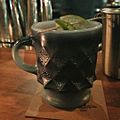Ginger tea facts for kids
| Ginger tea.jpg | |
| Type: | Herbal tea |
|
|
|
| Other names: |
|
| Origin: | Asia |
|
|
|
| Quick description: | Tea made from ginger |
|
|
|
| Temperature: | 100 °C (212 °F) |
| Time: | Varies |
Quick facts for kids Regional names |
|||||||||||||
|---|---|---|---|---|---|---|---|---|---|---|---|---|---|
| Chinese name | |||||||||||||
| Traditional Chinese | 薑母茶 | ||||||||||||
| Simplified Chinese | 姜母茶 | ||||||||||||
| Literal meaning | ginger mother (mature ginger) tea | ||||||||||||
|
|||||||||||||
| Korean name | |||||||||||||
| Hangul | 생강차 | ||||||||||||
| Hanja | 生薑茶 | ||||||||||||
| Literal meaning | ginger tea | ||||||||||||
|
|||||||||||||
| Japanese name | |||||||||||||
| Kanji | 生姜湯 | ||||||||||||
| Kana | しょうがゆ | ||||||||||||
|
|||||||||||||
| Malay name | |||||||||||||
| Malay | teh halia | ||||||||||||
| Indonesian name | |||||||||||||
| Indonesian | teh jahe | ||||||||||||
| Filipino name | |||||||||||||
| Tagalog | salabat | ||||||||||||
Ginger tea is a warm drink made from the root of the ginger plant. It is a type of herbal tea. People have enjoyed it for a very long time in many parts of Asia. It has been used as a traditional herbal medicine in East Asia, South Asia, Southeast Asia and West Asia.
Contents
How People Enjoy Ginger Tea
Ginger tea can be enjoyed on its own. Sometimes, people serve it with other things. These can include milk, slices of orange, or lemon.
-
Boiled lemon and ginger tea in Tanzania
Ginger Tea in East Asia
China's Ginger Tea History
Long ago, during the Tang Dynasty in China, people added flavors to tea. They did this to make the bitter taste less strong. Ginger was a very popular choice for flavoring tea. Other things like onion, orange peel, cloves, and peppermint were also used.
Japan's Shōgayu
In Japan, ginger tea is known as shōgayu. This name is written as 生姜湯 in Japanese.
Korea's Saenggang-cha
In Korea, ginger tea is called saenggang-cha. This name is written as 생강차; 生薑茶.
You can make saenggang-cha in a few ways. One way is to boil fresh slices of ginger in water. Another way is to mix ginger juice with hot water. People also use ginger that has been preserved in honey. This is called saenggang-cheong. You just mix it with hot water to make the tea.
Today, you can also find instant powdered versions of ginger tea. When served, saenggang-cha often has jujubes and pine nuts as a garnish. If you use fresh ginger, you can sweeten the tea. Honey, sugar, or other sweeteners can be added to your liking. Sometimes, garlic, jujubes, and pear are boiled with the ginger.
-
Saenggang-cha (ginger tea) made from saenggang-cheong (preserved ginger)
-
Saenggang-cheong (preserved ginger) made for saenggang-cha (ginger tea)
Ginger Tea in Southeast Asia
Brunei, Malaysia, and Singapore: Teh Halia
In Brunei, Malaysia, and Singapore, ginger tea is usually called teh halia. This is not just pure ginger tea. It is made with strong, sweetened black tea. It also includes ginger root, sugar, and milk or condensed milk.
Indonesia: Teh Jahe and Wedang Jahe
In Indonesia, ginger tea is known as teh jahe. In the region of Java, a special kind of ginger tea is very popular. It is called wedang jahe. This version is made richer with palm sugar and spices.
The word wedang in the Javanese means "hot drink". The word jahe means "ginger". Even though it does not have caffeine, people often drink it to feel refreshed. It is made from the root of the ginger plant. The ginger is usually fresh and cut into thin slices. It also contains palm sugar or regular cane sugar. Often, fragrant pandan leaves are added too. You can use brown sugar or honey instead of palm sugar. Traditionally, people might add spices like lemongrass, cloves, and cinnamon sticks.
Sometimes, fresh milk or condensed milk is added to wedang jahe.
-
Wedang jahe (Javanese ginger tea) in Surakarta, Central Java, with bits of spices
Philippines: Salabat
In the Philippines, ginger tea is called salabat. It is traditionally made simply. You peel and thinly slice or crush raw ginger. Then, you boil it in water for a few minutes. Sugar, honey, and calamansi are added to taste. Other flavors can be added if you like. Modern versions can also use powdered ginger. This is often called "instant salabat". You just add it to hot boiling water. People prefer native ginger types because they are smaller and have a stronger taste.
Salabat is usually served in December, which is a cooler month. It is often paired with traditional rice cakes (kakanin). Examples include bibingka or puto bumbong. Salabat is traditionally sold by street vendors early in the morning. This happens during the Simbang Gabi (dawn mass) of the Christmas season.
Salabat is also widely used as a remedy for sore throats, coughs, and common colds. Many people believe that drinking salabat can help improve a person's singing voice.
There is a type of salabat that uses turmeric. This variant is known as dulaw, duwaw, or duyaw in the Visayas and Mindanao islands. In the Filipino language, it is called tsaang dilaw, which means "yellow tea".
-
Salabat from Pampanga
Ginger Tea in South Asia
India: Adrak ki Chai
In India, ginger tea is known as Adrak ki chai. It is a very popular drink. It is made by grating ginger into brewed black tea. Milk and sugar are also added. Another common version is ginger lemon tea. This is made by adding ginger root to warm lemon juice.










